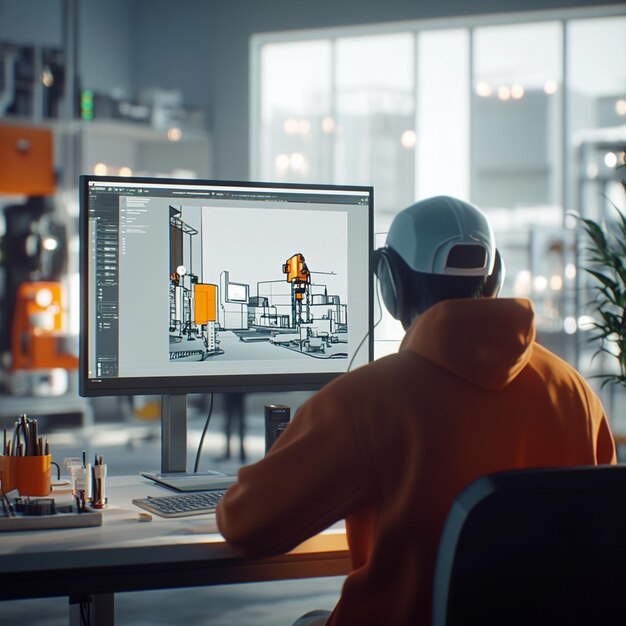
How AI is Revolutionizing the CAD Industry
The CAD (Computer-Aided Design) industry has long been at the forefront of innovation, enabling professionals to create detailed and precise designs across various sectors. With the advent of Artificial Intelligence (AI), CAD is experiencing a revolutionary transformation. This change has led to faster workflows, more accurate designs, and previously unattainable levels of customization. Companies like ALCAD are leveraging these advancements to redefine what is possible in the design world.
Let’s explore how AI is reshaping CAD modeling software and its profound implications for industries worldwide.
AI-Driven Design Innovation in CAD Modeling Software
AI has introduced a new era of intelligence in CAD modeling software, empowering it to function as more than just a tool for drafting and drawing. AI algorithms now analyze massive datasets, identify design patterns, and even generate design suggestions. For example, a designer working on a mechanical assembly can input specific parameters such as weight, dimensions, or material properties. AI-powered CAD tools process this data, providing optimized design variations that adhere to these constraints. Such capabilities significantly reduce design time and push the boundaries of creativity, offering opportunities for groundbreaking innovations. ALCAD’s focus on integrating these AI-driven features into its software ensures that users are equipped to tackle complex design challenges effortlessly.Automation: The Future of CAD
Automation is one of the most transformative aspects of AI in computer-aided drawing software. AI automates repetitive and time-intensive tasks such as:- Drafting: Automated dimensioning and annotations speed up documentation processes.
- Error Detection: AI can detect clashes, inconsistencies, or violations of design rules in real time.
- Optimization: It analyzes the design for performance, cost, and manufacturability, suggesting necessary adjustments automatically.
Generative Design: A Game-Changer
AI has brought generative design to the forefront of CAD. Generative design involves inputting a set of constraints and goals—such as weight, strength, or material usage—into the software. AI then produces multiple design options, sometimes in minutes, that meet these parameters. For instance, in the automotive or aerospace industries, generative design enables the creation of lightweight, efficient components that maintain structural integrity. Traditional methods often make such designs impossible to achieve. Generative design also reduces prototyping costs, as the AI-optimized designs are ready for manufacturing or 3D printing with minimal modification. ALCAD is embracing generative design as part of its mission to empower designers with cutting-edge capabilities.Real-Time Feedback and Suggestions
One of the standout benefits of AI in CAD software programs is the ability to provide real-time feedback. AI doesn’t just execute commands—it acts as a partner to the designer. For example, if a designer is creating an assembly, the AI can immediately highlight issues like interference between parts or suggest alternative configurations. Similarly, during architectural design, AI can recommend energy-efficient layouts based on environmental data. By functioning as a real-time advisor, AI reduces errors, ensures compliance with design rules, and promotes sustainable practices.Customization and Personalization in CAD
In today’s competitive environment, customization is essential. AI empowers CAD modeling software to deliver highly personalized designs. By analyzing customer preferences, AI can recommend design elements tailored to specific needs. For example:- Interior designers can use AI to create layouts that match their clients’ tastes and preferences.
- Product designers can leverage AI to generate consumer-specific features, enhancing user satisfaction.
Streamlining Collaboration
AI-powered computer-aided drawing software has also improved collaboration across teams. Cloud-based AI platforms allow multiple designers to work on the same project simultaneously. These platforms integrate AI to ensure version control, suggest improvements in real time, and enable seamless communication. For global organisations, AI-driven CAD solutions bridge the gap between teams in different locations, fostering faster and more cohesive project completion.Reducing Time-to-Market
In industries where time-to-market is critical, AI in CAD plays a vital role. By automating processes, optimising designs, and providing real-time feedback, AI reduces the overall project timeline. For instance, in product design, an AI-driven CAD solution can complete tasks in days that previously took weeks. This efficiency accelerates innovation and ensures that businesses can deliver their products faster while maintaining quality.Challenges and Overcoming Barriers
While AI offers incredible opportunities, it also presents challenges in its adoption:- Learning Curve: AI tools require designers to learn new workflows and skills.
- Integration Costs: Upgrading existing CAD systems with AI capabilities may demand significant investment.
- Data Dependency: AI relies on high-quality data, and any errors in data can lead to suboptimal outcomes.
Future Trends in AI and CAD
The future of AI in CAD modeling software looks incredibly promising. Emerging trends include:- AI-Powered Simulation: Predicting the performance of designs under real-world conditions will become more accurate and accessible.
- Natural Language Processing (NLP): Designers may soon be able to describe their requirements verbally, and the AI will generate models accordingly.
- AI-Enhanced Virtual Reality (VR): Combining AI with VR will enable immersive design experiences in which designers can interact with 3D models in real-time.
- Sustainability-Focused Designs: AI will prioritise energy-efficient and eco-friendly solutions, meeting global sustainability goals.
Conclusion: Why Choose ALCAD?
The integration of AI into CAD has transformed the industry, offering unparalleled design possibilities and efficiency. From generative design to real-time feedback, AI-powered CAD solutions are driving innovation across industries. As a leader in this space, ALCAD is dedicated to providing state-of-the-art CAD modeling software equipped with AI capabilities. Whether you’re a seasoned professional or just starting in the field, ALCAD offers tools that enhance your creativity, streamline workflows, and reduce time-to-market. Take the first step into the future of design with ALCAD’s AI-enhanced solutions. Revolutionize the way you work—one design at a time.